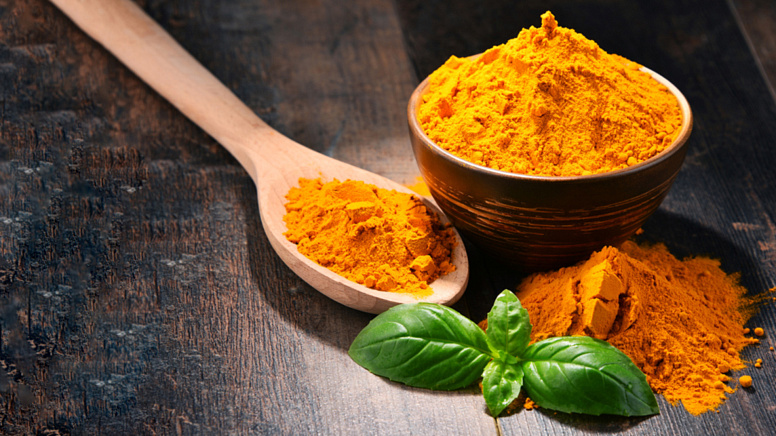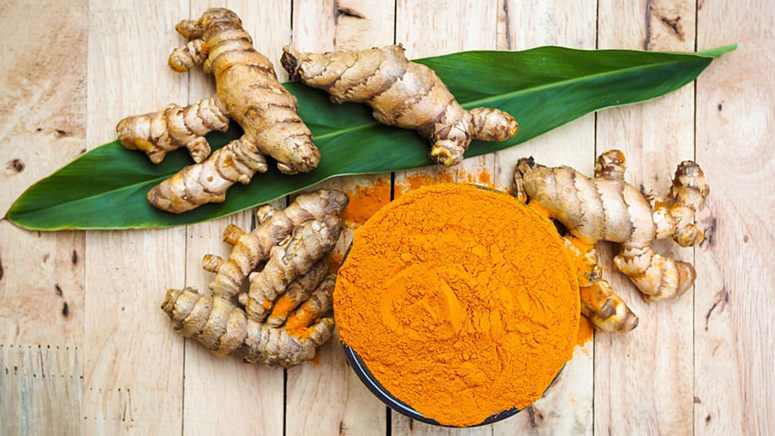India is always close by. It seems like a tour operator’s slogan, but in reality it’s true. Even people who are distant from yoga and Ayurveda keep and use one of the world’s most famous spices– turmeric. Not many people know that in addition to its direct purpose, the spice is also applied as medicine. Over the centuries, Ayurveda has accumulated a huge number of recipes using this spice. Which diseases can turmeric cure? How can you use it correctly so as not to harm yourself and your close ones? We will talk about this and so much more in the given article.
Turmeric: Ayurvedic properties
The history of turmeric goes back more than one millennium. The birthplace of turmeric is India, where people still treat this plant with reverence. Since ancient times, turmeric has been used not only for healing and cooking but also in religious rites. In particular, the ritual use of turmeric is characteristic of the worship of the goddess Lakshmi, one of the principal deities in Hinduism. Similarly, during major holidays in honor of Ganesha, followers of the cult sculpt an image of the deity with turmeric.
The spice is also applied to the body or to religious attributes– today in India, you can still find mala (rosary beads) for sale that have been treated with turmeric. Turmeric is used throughout India, and there are only two instances when the use thereof is strictly forbidden: the spice cannot be used if there is mourning in a house, and the same ban is imposed on widows.
In both instances, according to cultural belief, people must give up all of life’s pleasures, including turmeric. There exists another interesting, though more optimistic fact about turmeric: during the Kangana ceremony, its roots are strung on a thin strand, after which the future bride and groom exchange these sanctified pieces of jewelry. According to Indian laws, such a marriage is considered official and as legal as an official stamp in one’s passport. Another interesting function of turmeric is that it is brought as a gift to the house of a pregnant woman or one’s beloved, thereby showing care and guardianship of the woman.
Why turmeric? Due to its properties, about which you will learn below. It is important to note that turmeric is often called a yogi’s plant – it makes one’s joints flexible, increases their mobility, and helps prana flow freely through the body. Turmeric root is considered a powerful amulet and is worn around the neck to protect oneself from any evil or disease. If a believer in India wishes to protect their home from demons, they must splash a mixture of turmeric and lime on the four sides of their house.
Today, turmeric is sometimes called “Indian saffron,” and this comparison is not accidental. The world-famous traveler Marco Polo first tried turmeric in China, where it was imported from India in the fifth century. It was Polo who said that the spice’s color and smell were reminiscent of saffron, but at the same time it remained a separate culture. By the way, China is one of the few countries where turmeric successfully took root and was subsequently cultivated. Turmeric has unique taste qualities and a wide range of useful properties, because of which many in India believe that the spice is none other than gold, awarded by the merciful gods to their worshippers. It is generally accepted that this spice personifies sattva guna, therefore its use endows a person with goodness, energy, and harmony.
Turmeric is planted in late April to early May and dug up after 9 months. After several days, the rhizomes are boiled for about an hour in water with added calcium bicarbonate, then taken out and dried in the sun once the plant becomes soft. Turmeric is a very inexpensive root, so Hindus, emphasizing the baseness of a person, say that he is “not even worth a turmeric root.”
The benefits of turmeric are described in ancient Ayurvedic treatises, specifically the “Sushruta Samhita,” which mentions that the spice contains three rasas (tastes): astringent, bitter, and pungent. It also has vipaka– a sharp aftertaste. The “Sushruta Samhita” also says that turmeric cleanses the energy channels and normalizes the state of the chakras and the subtle body of a person. The treatise mentions another key difference between turmeric and other spices: it suits all doshas without exception, so the spice is included in nearly 80% of Ayurvedic preparations.
Regular use of turmeric strengthens a person’s immune system, destroying bacteria and viruses, while positively affecting the gastrointestinal tract by restoring the intestinal microflora. That is why not only Eastern but also Western medicine recommends using turmeric in the postoperative period.
Turmeric is especially useful for women’s health: the spice is used to treat and prevent problems such as PMS and painful menstruation, reproductive system problems, and breast tumors. Curcumin (a component of the spice) is used in Ayurveda to treat respiratory diseases, particularly runny nose and flu. Huge Indian pharmaceutical companies include turmeric in their remedies for the common cold.
The use of turmeric in Ayurveda
Let’s talk in detail about how to use turmeric from an Ayurvedic point of view. Turmeric, as noted above, is beneficial for the female body, especially during preparation for childbirth. In the late stages of pregnancy, it is recommended to drink milk with added turmeric: add ¼ tsp turmeric to a glass of hot milk and drink the product once a day before bed.
In the case of gastrointestinal diseases, upset stomach, and flatulence, a similar portion of turmeric should be added to a glass of warm water and thoroughly mixed. It should be taken three times a day, one glass before each meal.
For diabetes, after receiving a doctor’s approval, you can add mumijo, i.e. shilajit, and turmeric to your course of treatment. Make sure there are 500 mg of turmeric per mumijo capsule and take this three times daily.
For those who wish to lose weight, turmeric can become a reliable assistant. To decrease appetite, take a glass of aloe juice with ¼ tsp of the spice; a similar portion of turmeric can be mixed with warm water and drunk in the morning on an empty stomach. Not only will this reduce appetite, but it will invigorate and energize the body. And if you add the juice of half a lemon, you will saturate the body with useful vitamins and strengthen your immunity.
During colds, mix 1 tsp of turmeric with a glass of warm water, add a pinch of salt, and drink three times a day. For sore throats, which often accompany colds, mix turmeric with honey and dissolve it slowly in your mouth throughout the day. Ayurvedic doctors also suggest massaging your chest and throat during a cold; for the massage, you can use a mixture of turmeric, black pepper, and ghee. A mixture of ghee and turmeric can be applied to the sinuses in case of a runny nose.
Thanks to the accumulated experience of turmeric’s beneficial properties, Ayurveda suggests using the spice to treat bleedings gums. Mix turmeric with warm water and rinse your mouth several times daily; turmeric will relieve inflammation and heal wounds on the gums.
In case of asthma, and after consulting a doctor, you can drink milk with turmeric three times a day. Half a teaspoon of turmeric should be added to a glass of milk and brought to a boil. It is recommended to drink such milk three times daily on an empty stomach.
Often in adolescence, the problem of acne and pimples arises. Instead of purchasing expensive products with questionable composition, make your own remedy from turmeric. Mix 1 tbsp of aloe juice with ¼ tsp of turmeric and take the product twice daily until you achieve the desired result. For external use, mix 1 tsp of turmeric with the same amount of black clay. Mix thoroughly and apply to the affected area of the skin. Make sure to wash off the mask after 10 minutes and repeat the procedure once every three days for two weeks.
For burns, it is recommended to mix aloe juice and turmeric until mushy and apply to the affected area. But if you replace aloe juice with lemon juice and add a pinch of salt, you’ll get an excellent remedy for sprains.
Few people know that turmeric can replace the widely-known triphala without harming the body. Triphala, just like turmeric, balances all three doshas, but it isn’t always available for purchase. Here, another recipe with turmeric from Ayurveda’s arsenal will come to the rescue. Only 2-3 teaspoons of aloe juice with a pinch of turmeric, which should be drunk three times daily, will replace triphala in its qualities. At the same time, it is better to pair the given remedy with a diet that corresponds to your dosha– this will greatly strengthen the effect of the turmeric. It’s also important to use natural aloe juice, in alignment with one of most important Ayurvedic principles: all products should neither be canned nor live, otherwise there will be no effect from their use. Today, a plant such as aloe can be found on every windowsill, and if not, you should consider its purchase– this plant is a treasure trove of vitamins and useful microelements.
Turmeric is also used for cosmetic purposes. However, before making turmeric masks, keep in mind that those with overly sensitive skin should abstain from this treatment. Also, turmeric masks should not be applied around the eyes.
For rejuvenation, Ayurveda gives the following recipe: combine 1 tsp of honey with 1 tsp each of heavy cream and turmeric. Mix thoroughly and apply to the skin for 20 minutes, then wash off the mask. Re-apply it after 3-4 days, but make sure the course of application doesn’t exceed 3 weeks in length. For sensitive skin, honey can be replaced with a similar amount of aloe juice.
Also use turmeric to strengthen hair and improve its growth and health, but in combination with chickpea flour. If chickpea flour is not available, you can replace it with wheat flour. Mix the spice with twice as much flour, pour in warm water and stir until mushy. Apply the mixture to your hair after letting it sit for 5-10 minutes. Leave the mask on your hair for 15 minutes then thoroughly rinse it out.
Turmeric is a reliable friend and assistant not only in the kitchen, but also in matters of health and cosmetology. Use the advice you’re given wisely, after you’ve received a preliminary consultation with a specialist. Especially if you’re taking medications prescribed by a doctor, do not use turmeric during periods of exacerbation of gastrointestinal diseases and gallstone disease. Take care of yourself and your loved ones.

